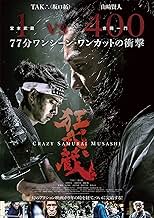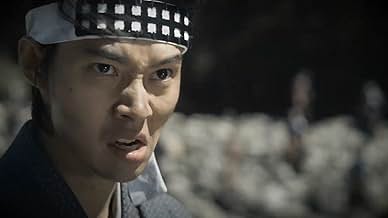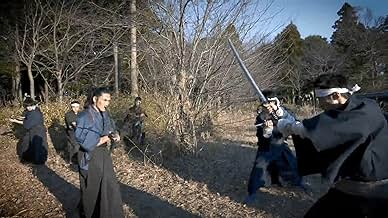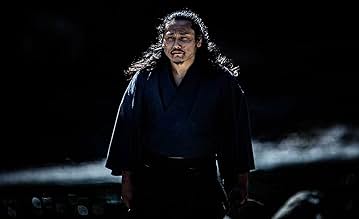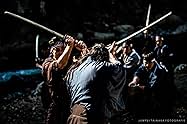Kyô Samurai Musashi
- 2020
- 1h 31min
VALUTAZIONE IMDb
4,6/10
1058
LA TUA VALUTAZIONE
La battaglia più famosa dello spadaccino Miyamoto Musashi. Non c'è spazio per errori, non c'è spazio per mosse banali o poco convincenti.La battaglia più famosa dello spadaccino Miyamoto Musashi. Non c'è spazio per errori, non c'è spazio per mosse banali o poco convincenti.La battaglia più famosa dello spadaccino Miyamoto Musashi. Non c'è spazio per errori, non c'è spazio per mosse banali o poco convincenti.
- Regia
- Sceneggiatura
- Star
Recensioni in evidenza
Crazy Samurai: 400 vs. 1, also known as Crazy Samurai Musashi, is based upon writer, swordsman, strategist, ronin and philosopher Musashi Miyamoto who has inspired numerous legends. This low-budget movie shows how the titular hero confronts four hundred swordsmen when arriving to duel the disgraced Yoshioka dojo.
This movie can be separated into three scenes. The first scene is filled with atmosphere, context and tension as the members of the disgraced dojo expect the swordsman to arrive. They are planning on ambushing him but are obviously underestimating their enemy's wit.
The second scene has been filmed in one single take and lasts for seventy-seven minutes. Musashi Miyamoto confronts his enemies. They fight in a forest, on a field, in a house, in a court and later on in a small village. There are a few elements that offer some short breaks from the fight sequences such as the protagonist's brief monologues, the argument between two samurai and a peasant girl who betrays the hero.
The final scene takes place several years after the events portrayed before. It shows us what Musashi Miyamoto has become and what his foes are willing to do to murder him for once and for all.
The movie title already indicates exactly what you get here. This film is filled with fight scenes from start to finish. The stamina of lead actor Sakaguchi Taku is quite remarkable. The beautiful locations bring to life Japan in the early seventeenth century. Some of the fight scenes end up being a little bit repetitive. The visual effects look quite cheap but one gets used to them. The ending of the second scene felt a little bit unfinished in my opinion but didn't have an overall negative impact.
To keep it short, this movie is only interesting for martial arts enthusiasts and people who are interested in Japanese culture, history and legends. The movie has an unusual approach which makes it interesting to watch despite some repetition here and there. You should not expect witty dialogues, profound plot and unexpected twists here. Genre fans will get what they want and everyone else should simply ignore this film.
This movie can be separated into three scenes. The first scene is filled with atmosphere, context and tension as the members of the disgraced dojo expect the swordsman to arrive. They are planning on ambushing him but are obviously underestimating their enemy's wit.
The second scene has been filmed in one single take and lasts for seventy-seven minutes. Musashi Miyamoto confronts his enemies. They fight in a forest, on a field, in a house, in a court and later on in a small village. There are a few elements that offer some short breaks from the fight sequences such as the protagonist's brief monologues, the argument between two samurai and a peasant girl who betrays the hero.
The final scene takes place several years after the events portrayed before. It shows us what Musashi Miyamoto has become and what his foes are willing to do to murder him for once and for all.
The movie title already indicates exactly what you get here. This film is filled with fight scenes from start to finish. The stamina of lead actor Sakaguchi Taku is quite remarkable. The beautiful locations bring to life Japan in the early seventeenth century. Some of the fight scenes end up being a little bit repetitive. The visual effects look quite cheap but one gets used to them. The ending of the second scene felt a little bit unfinished in my opinion but didn't have an overall negative impact.
To keep it short, this movie is only interesting for martial arts enthusiasts and people who are interested in Japanese culture, history and legends. The movie has an unusual approach which makes it interesting to watch despite some repetition here and there. You should not expect witty dialogues, profound plot and unexpected twists here. Genre fans will get what they want and everyone else should simply ignore this film.
Miyamoto Musashi was a very interesting Japanese Ronin in Japan's era's of swordsmen and Samurai history. Throw in Tak Sakguchi playing Musashi and I was all set for an amazing action film. How wrong I was!
It dragged on and on with poor fight choreography and too few extras playing his enemies (it became very apparent, after 10 minutes, that the same dead guys were coming back time and time again). There were no exiting moments, no edge of your seat grippers but, there were many sword style errors; which in real life he would have been killed.
Overall i think it was poorly conceived, directed and acted with terrible choreography.
A brief HISTORY of the warrior who was the Bruce Lee of ancient Japanese swordsmen. Miyamoto Musashi, also known as Shinmen Musashi no Kami Fujiwara no Harunobu, Shinmen Takezo, Miyamoto Bennosuke or, by his Buddhist name, Niten Doraku, was a Japanese swordsman, philosopher, strategist, writer and Ronin. Musashi, as he was often simply known, became renowned through stories of his unique double-bladed swordsmanship and undefeated record in his 61 duels. He is considered a Kensei, a sword-saint of Japan. He was the founder of the Niten Ichi-ryu, or Nito Ichi-ryu, style of swordsmanship, and in his final years authored The Book of Five Rings and Dokkodo. Both documents were given to Terao Magonojo, the most important of Musashi's students, seven days before Musashi's death. The Book of Five Rings deals primarily with the character of his Niten Ichi-ryu school in a concrete sense, i.e., his own practical martial art and its generic significance; The Path of Aloneness, on the other hand, deals with the ideas that lie behind it, as well as his life's philosophy in a few short aphoristic sentences. Born:Shinmen Bennosuke, c.1584, Harima Province or Mimasaka Province, Japan. Died:June 13, 1645, Higo Province, Japan.
A brief HISTORY of the warrior who was the Bruce Lee of ancient Japanese swordsmen. Miyamoto Musashi, also known as Shinmen Musashi no Kami Fujiwara no Harunobu, Shinmen Takezo, Miyamoto Bennosuke or, by his Buddhist name, Niten Doraku, was a Japanese swordsman, philosopher, strategist, writer and Ronin. Musashi, as he was often simply known, became renowned through stories of his unique double-bladed swordsmanship and undefeated record in his 61 duels. He is considered a Kensei, a sword-saint of Japan. He was the founder of the Niten Ichi-ryu, or Nito Ichi-ryu, style of swordsmanship, and in his final years authored The Book of Five Rings and Dokkodo. Both documents were given to Terao Magonojo, the most important of Musashi's students, seven days before Musashi's death. The Book of Five Rings deals primarily with the character of his Niten Ichi-ryu school in a concrete sense, i.e., his own practical martial art and its generic significance; The Path of Aloneness, on the other hand, deals with the ideas that lie behind it, as well as his life's philosophy in a few short aphoristic sentences. Born:Shinmen Bennosuke, c.1584, Harima Province or Mimasaka Province, Japan. Died:June 13, 1645, Higo Province, Japan.
Totally unrealistic.
95% of the actors who supposedly get killed either fall behind a tree/building, get concealed by a couple of other actors, or stumble out of the camera field of view. Only to reappear minutes later.
When the camera eventually pans around only 2-3 bodies are there instead of a pile of around 60+ corpses.
You end up watching the same repeated sequence over and over... one person at a time attacks, gets pommelled on the head, crawls off screen, and reappears a few minutes later.
I guess due to the lack of actors involved this was necessary, but this is child's playground fare in its execution. An army being represented by a dozen or so people constantly running around the cameraman is beyond acceptable.
95% of the actors who supposedly get killed either fall behind a tree/building, get concealed by a couple of other actors, or stumble out of the camera field of view. Only to reappear minutes later.
When the camera eventually pans around only 2-3 bodies are there instead of a pile of around 60+ corpses.
You end up watching the same repeated sequence over and over... one person at a time attacks, gets pommelled on the head, crawls off screen, and reappears a few minutes later.
I guess due to the lack of actors involved this was necessary, but this is child's playground fare in its execution. An army being represented by a dozen or so people constantly running around the cameraman is beyond acceptable.
Very cool to pull a "one shot" off, but man did it ever trade that for the things I expect in a hardcore samurai movie. Not even ONE decapitation. So sad...
This is a Japanese movie? But calling it a movie is a stretch. Also apart from a exposition dump in the first 5 minutes there is about 10 lines so not that much Japanese in it. They spend over an hour with one samurai guy taking on an endless supply of stunt guys. Poor quality you could find better quality at a medieval fair show. To be fair they do slowly walk through a model Japanese village during it. It's boring what can I say how long does it take watching Japanese men struggling out of shot after being sliced then to immediately join the endless supply of grunts. It feels like a beat them up video game without any inputs and it's stuck in an endless cutscene which never ends.
Lo sapevi?
- QuizActor Tak Sakaguchi broke one finger, one rib and four of his teeth during the 77 minute battle sequence.
- BlooperMusahashi couldn't have known where to immediately find something to drink for each of his several breaks in a deserted village on the other clan's turf.
I più visti
Accedi per valutare e creare un elenco di titoli salvati per ottenere consigli personalizzati
- How long is Crazy Samurai Musashi?Powered by Alexa
Dettagli
- Data di uscita
- Paese di origine
- Sito ufficiale
- Lingua
- Celebre anche come
- Crazy Samurai Musashi
- Aziende produttrici
- Vedi altri crediti dell’azienda su IMDbPro
- Tempo di esecuzione1 ora 31 minuti
- Colore
- Proporzioni
- 1.78 : 1
Contribuisci a questa pagina
Suggerisci una modifica o aggiungi i contenuti mancanti



